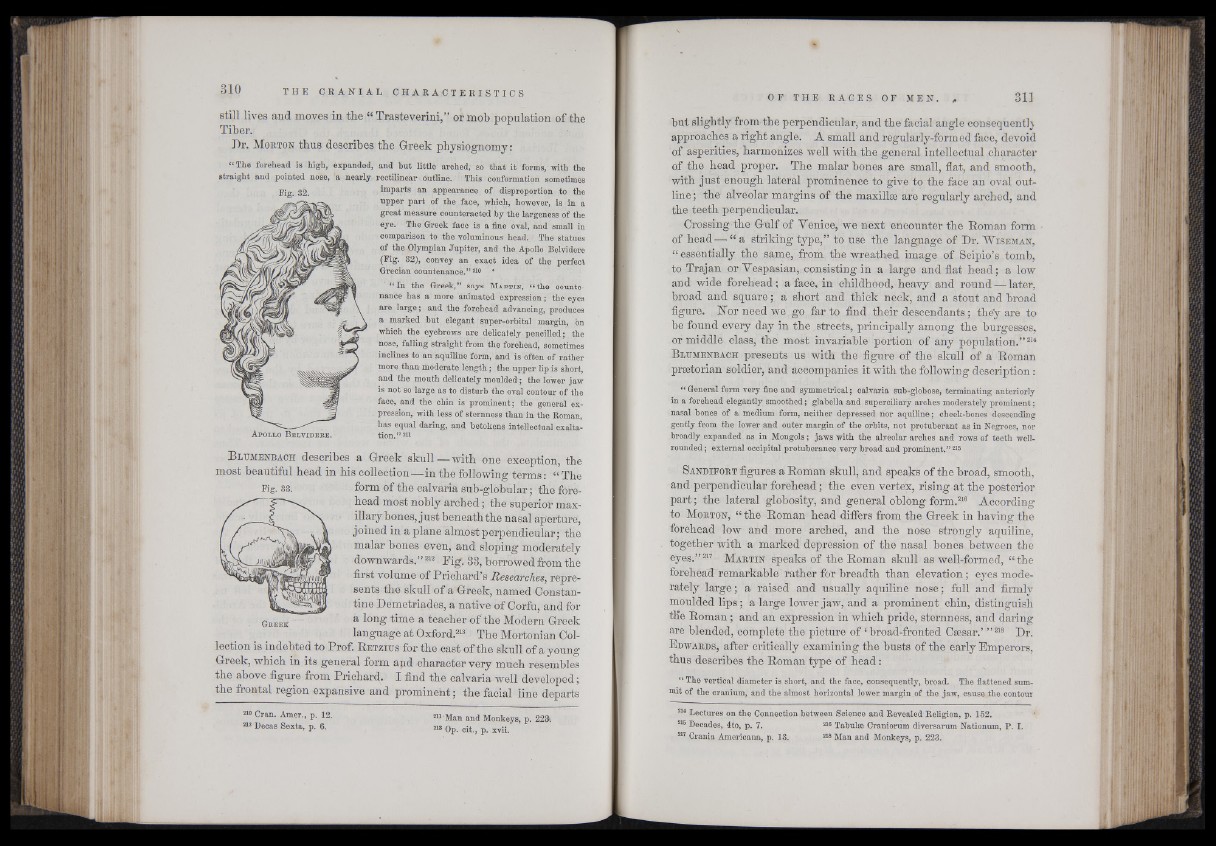
still lives and moves in the “ Trasteverini,” or mob population of the
Tiber.
Dr. M orton thus describes the Greek physiognomy:
“ The forehead is high, expanded, and but little arched, so that it forms, with the
straight and pointed nose, a nearly rectilinear Outline. 1 This conformation sometimes
Eig. 32. imparts an appearance of disproportion to the
upper part of the face, which, however, is in a
great measure counteracted by the largeness of the
eye. The Greek face is a fine oval, and small in
comparison to the voluminous head. The statues
of the Olympian Jupiter, and the Apollo Belvidere
(Fig. 82), convey an exact idea of the perfect
Grecian countenance.51210 *
“ In the Greek,” says M a r t in , “ the countenance
has a more animated expression; the eyes
are large; and the forehead advancing, produces
a marked but elegant super-orbital margin, bn
which the eyebrows are delicately pencilled; the
nose, falling straight from the forehead, sometimes
inclines to an aquiline form, and is often of rather
more than moderate length; the upper lip is short,
and the mouth delicately moulded; the lower jaw
is not so large as to disturb the oval contour of the
face, and the chin is prominent; the general expression,
with less of sternness than in the Roman,
has equal daring, and betokens intellectual exalta-
A po l l o B e l v id b r e . tion.” 211
B ltjmenbach describes a Greek skull — with, one - exception, the
most beautiful head in his collection—in the following terms: “ The
Fig. 33. form of the calvaría sub-globular; the forehead
most nobly arched; the superior maxillary
bones, just beneath the nasal aperture,
joined in aplane almost perpendicular; the
malar bones even, and sloping moderately
downwards.”213 Big. 33, borrowed from the
first volume of Prichard’s Researches, represents
the skull of a Greek, named Constantine
Demetriades, a native of Corfu, and for
Geí¡ek: a long time a teacher of the Modern Greek
language at Oxford.213 The Mortonian Collection
is indebted to Prof. R e tz iu s for the east of the skull of a young
Greek, which in its general form apd character very much resembles
the above figure from Prichard. I find the calvaría well developed;
the frontal region expansive and prominent; the facial line departs
Cran. Amer., p. 12.
az Becas Sexta, p. 6.
211 'Man and Monkeys, p. 223>.
213 Op. oit., p. xvii.
but slightly from the perpendicular, and the facial angle consequent]}
approaches a right angle. A small and regularly-formed face, devoid
of asperities, harmonizes well with the general intellectual character
of the head proper. The malar bones are small, flat, and smooth,
with just enough lateral prominence to give to the face an oval outline;
the alveolar margins of the maxillae are regularly arched, and
the teeth perpendicular.
Crossing the Gulf of Venice, we next encounter the Roman form
of head — | a striking type,” to use the language of Dr. W isem a n ,
“ essentially the same, from the wreathed image of Scipio’s tomb,
to Trajan or Vespasian, consisting in a large and flat head; a low
and wide forehead ; a face, in childhood, heavy and round — later,
broad and square; a short and thick neck, and a stout and broad
figure. hTor need we go far to find their descendants; they are to
be found every day in the streets, principally among the burgesses,
or middle class, the most invariable portion of any population.”214
B ltjmenbach presents, us with the figure of the skull of a Roman
praetorian soldier, and accompanies it with the following description:
11 General form very fine and symmetrical; calvaria sub-globose, terminating anteriorly
in a forehead elegantly smoothed; glabella and superciliary arches moderately prominent;
nasal bones of a medium form, neither depressed nor aquiline; cheek-bones descending
gently from the lower and outer margin of the orbits, hot protuberant as in Negroes, nor
broadly expanded as in Mongols; jaws with the alveolar arches and rows of teeth well-
rounded; external occipital protuberance very broad and prominent.” 215
S a n d ifo r t figures a Roman skull, and speaks of the broad, smooth,
and perpendicular forehead; the even vertex, rising at the posterior
part; the lateral globosity, and general oblong form.216 According
to M orton, “ the Roman head differs from the Greek in having the
forehead low and more arched, and the nose strongly aquiline,
together with a marked depression of the nasal bones between the
eyes.”217 M a r t in speaks of the Roman skull as well-formed, “ the
forehead remarkable rather for breadth than elevation; eyes moderately
large; a raised and usually aquiline nose; full and firmly
moulded lips; a large lower jaw, and a prominent chin, distinguish
the Roman; and an expression in which pride, sternness, and daring
are blended, complete the picture of ‘broad-fronted Csesar.’ ”218 Dr.
E dwards, after critically examining the busts of the early Emperors,
thus describes the Roman type of head:
“ The vertical diameter is short, and the face, consequently, broad. The flattened sum,
nut of the cranium, and the almost horizontal lower margin of the jaw, cause the contour
2W Lectures on the Connection between Science and Revealed Religion, p. 152.
215 Decades, 4to, p. 7. 216 Tabulae Craniorum diversarum Nationum, P. I.
217 Crania Americana, p. 13. 218 Man and Monkeys, p. 223.